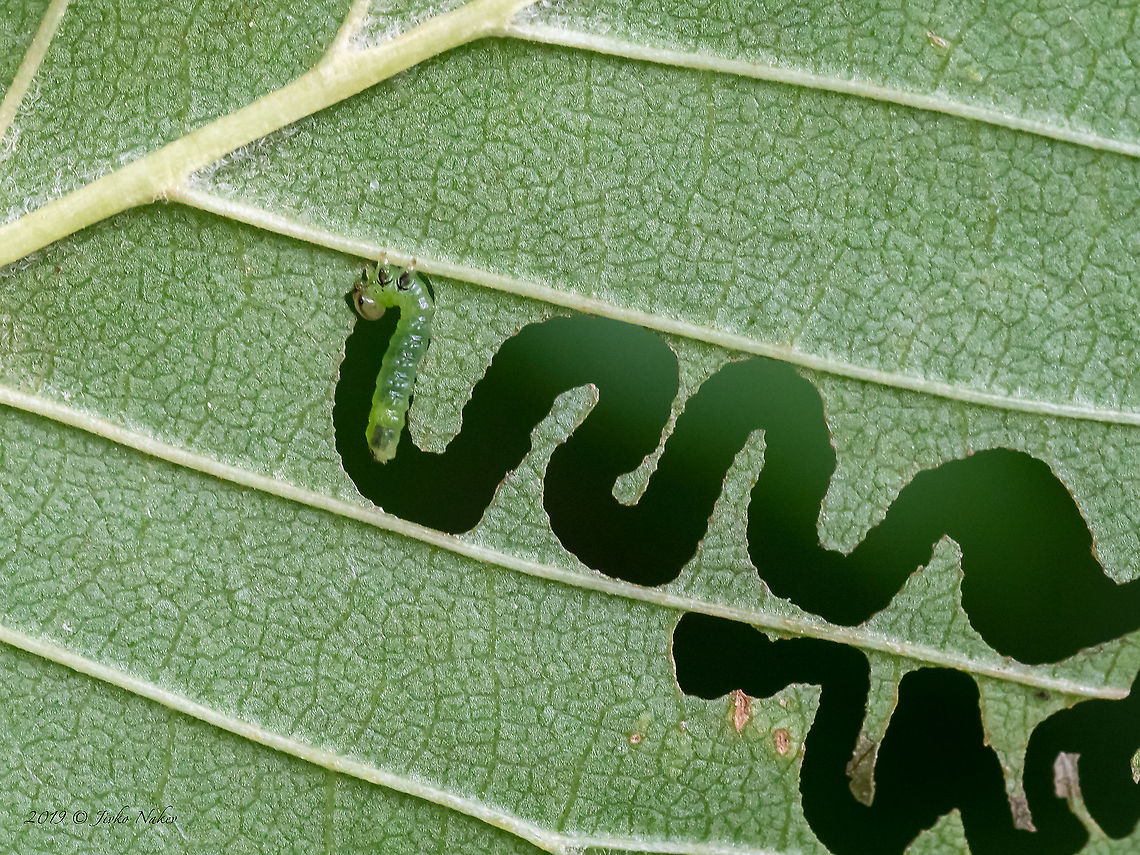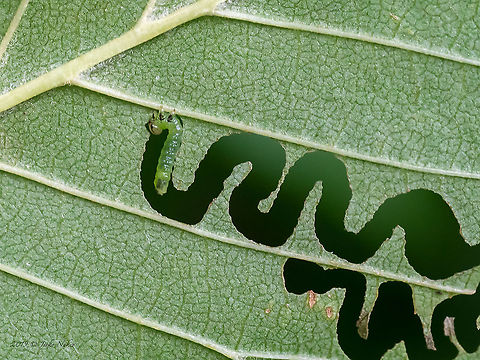 PromotedSpecies introCountry intro
PromotedSpecies introCountry intro
Elm Zigzag Sawfly larva - Aproceros leucopoda
Invasive species. An abstract from a study, published in the European Journal of Entomology in 2010.
"An invasive sawfly Aproceros leucopoda Takeuchi, 1939, which originates from East Asia, has colonized elms (Ulmus spp.) in Austria, Hungary, Poland, Romania, Slovakia and Ukraine, at least since 2003. In Europe, the larvae can completely defoliate native and non-native elm trees and may cause at least partial dieback. Field observations indicate that elms are infested independently of their age and site characteristics. The life cycle of A. leucopoda is described based on material reared in Hokkaido, Japan.
Parthenogenetic reproduction, the short life cycle of summer generations and the ability to produce four generations per year result in the production of numerous progeny. The evolution of a seasonal dimorphism in head morphology, a simple cocoon that is attached directly to the host plant and a short period spent in the cocoon stage during summer, are putative apomorphies shared by Aproceros Takeuchi, 1939 and Aprosthema Konow, 1899. These traits reduce developmental costs and contribute to the proliferation of A. leucopoda. No specialized parasitoid, that can effectively reduce outbreaks of this species, is known. It is likely that this pest will spread into central and south-western Europe."


comments (11)
Posted 5 years ago
The elm zigzag sawfly (Aproceros leucopoda) is a pest of elm trees (Ulmus sp.). It’s a minor pest in its native range of eastern Asia; but, it has spread across Europe and into the UK, where it has the potential to be a more serious threat.
The adults are small, dark wasp-like insects. Larvae are tiny, green caterpillars. Adults lay eggs on the edges of elm leaves and the larvae hatch within 4-8 days. They feast on the leaves, creating a characteristic zigzag pattern, for a couple weeks before pupating on the underside of the leaves. The lifecycle is quite short, thus several generations can be produced in one summer and infestations can happen quickly. To make matters worse, the species may reproduce through parthenogenesis (asexually and without the need for sperm). Eliminating the need to mate means that populations can increase even more rapidly.
Under the right conditions, the larvae can severely defoliate trees. The extent of the defoliation determines whether the damage is merely detrimental to aesthetic value or if it will influence a tree’s health, leading to dieback of shoots and branches. Despite the extent of defoliation, it is likely that the elm zigzag sawfly could become a serious competitor of other elm foliage-feeding invertebrates, including native species that actually depend on elm trees for survival. {Spotted in Bulgaria by JungleDragon moderator, Jivko Nakev} #JungleDragon #Elmzigzagsawfly #Aprocerosleucopoda
For more awesome photos by Jivko: https://www.jungledragon.com/user/1332/popular
https://www.facebook.com/jungledragonwildlife Posted 5 years ago, modified 5 years ago
Happy New Year! To say that 2020 was a challenging year would be an understatement. But, it was not without beauty or inspiration. During 2020, the JungleDragon community uploaded more than 17,000 photos and over 3,700 new species to the website!
Thank you to all of our members and supporters for your passion, dedication to nature and photography, and encouragement! You make JungleDragon special, and we appreciate you!
We are excited to continue sharing, inspiring, and learning about nature together with you in 2021! We wish you all the best for the upcoming year!!
Here are ten of the most popular photos shared on JungleDragon during 2020! Enjoy!! {See photos for credits} #JungleDragon #Nature #2020
https://www.facebook.com/jungledragonwildlife Posted 4 years ago